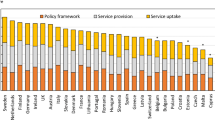Abstract
Summary
This report describes the epidemiology, economic burden and treatment of osteoporosis in Switzerland.
Introduction
Osteoporosis is characterized by reduced bone mass and disruption of bone architecture, resulting in increased risks of fragility fractures which represent the main clinical consequence of the disease. Fragility fractures are associated with substantial pain and suffering, disability and even death for the affected patients and substantial costs to society. The aim of this report is to describe the epidemiology and economic burden of fragility fractures as a consequence of osteoporosis in Switzerland, as a detailed addition to the report for the European Union (EU27): “Osteoporosis in the European Union: Medical Management, Epidemiology and Economic Burden”.
Methods
The literature on fracture incidence and costs of fractures in Switzerland was reviewed and incorporated into a model estimating the clinical and economic burden of osteoporotic fractures in 2010. Furthermore, data on sales of osteoporosis treatments and the population at high risk of fracture were used to estimate treatment uptake and treatment gap.
Results
It was estimated that approximately 74,000 new fragility fractures were sustained in Switzerland in 2010, comprising 14,000 hip fractures, 11,000 vertebral fractures, 13,000 forearm fractures and 36,000 other fractures (i.e. fractures of the pelvis, rib, humerus, tibia, fibula, clavicle, scapula, sternum and other femoral fractures). The economic burden of incident and previous fragility fractures was estimated at CHF 2,050 million for the same year. Incident fractures represented 76 % of this cost, long-term fracture care 21 % and pharmacological prevention 3 %. Previous and incident fractures also accounted for 24,000 quality-adjusted life years (QALYs) lost during 2010. When accounting for the demographic projections for 2025, the number of incident fractures was estimated at 98,786 in 2025, representing an increase of 25,000 fractures. Hip, clinical vertebral (spine), forearm and other fractures were estimated to increase by 4,900, 3,200, 3,500 and 13,000, respectively. The burden of fractures in terms of costs (excluding value of QALYs lost) in Switzerland in 2025 was estimated to increase by 29 % to CHF 2,642 million. Though the uptake of osteoporosis treatments increased from 2001, the proportion of patients aged 50 or above who received treatment remained at low levels in the past few years. The majority of women at high fracture risk do not receive active treatment.
Conclusions
In spite of the high cost of osteoporosis, a substantial treatment gap and projected increase of the economic burden driven by an aging population, the use of pharmacological prevention of osteoporosis is significantly less than optimal, suggesting that a change in health care policy concerning the disease is warranted.


Similar content being viewed by others
References
Hernlund E, Svedbom A, Ivergard M, Compston J, Cooper C, Stenmark J, McCloskey EV, Jonsson B, Kanis JA (2013) Osteoporosis in the European Union: medical management, epidemiology and economic burden. A report prepared in collaboration with the International Osteoporosis Foundation (IOF) and the European Federation of Pharmaceutical Industry Associations (EFPIA). Arch Osteoporos 8:136
SVGO (2010) Osteoporose: Prävention-Diagnostik-Behandlung
Lippuner K, Johansson H, Kanis JA, Rizzoli R (2009) Remaining lifetime and absolute 10-year probabilities of osteoporotic fracture in Swiss men and women. Osteoporos Int 20:1131–1140
Wasserfallen JB, Krieg MA, Greiner RA, Lamy O (2008) Cost effectiveness and cost utility of risedronate for osteoporosis treatment and fracture prevention in women: a Swiss perspective. J Med Econ 11:499–523
Lippuner K, Johansson H, Borgstrom F, Kanis JA, Rizzoli R (2012) Cost-effective intervention thresholds against osteoporotic fractures based on FRAX® in Switzerland. Osteoporos Int 23:2579–2589
Chevalley T, Guilley E, Herrmann FR, Hoffmeyer P, Rapin CH, Rizzoli R (2007) Incidence of hip fracture over a 10-year period (1991–2000): reversal of a secular trend. BONE 40:1284–1289
Lippuner K, Popp AW, Schwab P, Gitlin M, Schaufler T, Senn C, Perrelet R (2011) Fracture hospitalizations between years 2000 and 2007 in Switzerland: a trend analysis. Osteoporos Int 22:2487–2497
Wilmoth J (2010) Human Mortality Database. University of California, Berkeley (USA), and Max Planck Institute for Demographic Research (Germany) Available at www mortality org (data downloaded on 2005-10-27)
Looker AC, Orwoll ES, Johnston CC Jr, Lindsay RL, Wahner HW, Dunn WL, Calvo MS, Harris TB, Heyse SP (1997) Prevalence of low femoral bone density in older U.S. adults from NHANES III. J Bone Miner Res 12:1761–1768
(2014) Documed. Arzneimittel-Kompendium der Schweiz
(201) United Nations Department of Economic and Social Affairs-Population Division. World population prospects
Acknowledgments
The methodology used for this report is the same as that used for the report “Osteoporosis in the European Union: Medical Management, Epidemiology and Economic Burden” [1]. The original report was sponsored by an unrestricted educational grant from the European Federation of Pharmaceutical Industry Associations (EFPIA) and the International Osteoporosis Foundation (IOF). We acknowledge the help of Helena Johansson and Prof. Anders Odén for their calculations of fracture probability. We thank O Ström and F Borgström, prominent authors of an earlier report covering a similar topic in a sample of EU countries, for providing the template for the present report.
Conflicts of interest
None.
Author information
Authors and Affiliations
Corresponding author
Rights and permissions
About this article
Cite this article
Svedbom, A., Ivergård, M., Hernlund, E. et al. Epidemiology and economic burden of osteoporosis in Switzerland. Arch Osteoporos 9, 187 (2014). https://doi.org/10.1007/s11657-014-0187-y
Received:
Accepted:
Published:
DOI: https://doi.org/10.1007/s11657-014-0187-y




